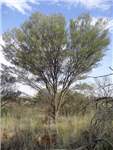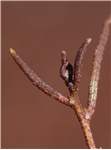Click on images
to enlarge

, Pilbara distribution map_sml.JPG)
, BRM 9211, stand_sml.jpg)
Photographer: B.R. Maslin

Photographer: J.E. Reid

Regrowth. Photographer: J.E. Reid
 possibly, BRM 9217, habit 3_sml.jpg)
Juvenile growth habit. Photographer: B.R. Maslin

Photographer: B.R. Maslin
 possibly, BRM 9217, phyllodes & branch 3_sml.jpg)
Photographer: B.R. Maslin
, flowering branch 2, BRM 8736_sml.jpg)
Photographer: B.R. Maslin
, juvenile foliage, pods green, BRM 8039_sml.jpg)
Photographer: B.R. Maslin
, BRM 9211, pods 3_sml.jpg)
Photographer: B.R. Maslin
, seeds (close), MET 17639, lab photo by FM_sml.jpg)
Seed from one herbarium voucher. Scale in mm. Photographer: F. McCallum
Botanical name
Acacia aneura var. tenuis Pedley, Fl. Australia 11B: 489 (2001)
Common name
Mulga
Note
Acacia aneura and related species form a very complex and polymorphic assemblage of taxa with A. aneura itself the most variable (see Miller et al. 2002 for discussion). These species are currently under review therefore the classification here of Pilbara entities referable to A. aneura is provisional. Currently 10 varieties are recognized within A. aneura (Pedley 2001) of which six appear to occur in the Pilbara. These varieties encompass most of the variation in Mulga in the Pilbara and are the entities upon which this Wattles of the Pilbara treatment of Mulga is based. It is often difficult to distinguish between the varieties, and between A. aneura and related species (especially A. ayersiana and A. paraneura) on account of seemingly intermediate forms. In past literature it is often not possible to know to which of the varieties the information applies. Therefore, we have assembled these data under the heading of A. aneura. The data presented below for A. aneura var. tenuis is derived from our field and herbarium studies of only the Pilbara plants of this entity.
Description
Rounded or obconic trees 3-6 (-8) m tall, often dividing at ground level into two to several, sub-straight main stems, crowns spreading with the branches ascending to erect and ±straight; young plants can have pseudo-conifer growth form. Branchlets ribless or very obscurely ribbed at extremities (ribs occasionally slightly resinous with translucent resin). Brachyblasts absent except occasionally present on young plants where the phyllodes may occur in small clusters of 2 or 3. New shoots dull brownish and resinous when first initiated. Phyllodes narrowly linear, (40-) 50-100 (-130) mm long (but often shorter on younger plants, 20-25 mm long), (1-) 1.5-2 (-3) mm wide, flat, ±straight to shallowly or moderately incurved, sometimes shallowly sigmoid or wavy, green but aging grey-green or dull sub-glaucous; parallel longitudinal nerves numerous, fine, close together, resinous (resin most evident on young phyllodes). Gland 0-1 mm above the pulvinus. Inflorescences simple; peduncles 5-10 mm long; spikes (10-) 15-35 mm long. Sepals free, linear-spathulate. Pods (15-) 20-60 mm long, 8-12 mm wide, papery, nerveless to very obscurely nerved, sub-glabrous with minute appressed hairs, light brown or orange-brown; marginal wing absent. Seeds oblique in the pods, 4-6 mm long, 3-3.5 mm wide.
Distribution and ecology
Variety tenuis is found mostly in areas from the Fortescue River southwards; it is particularly common on the Bajadas slopes around Coondewanna Flats near West Angelas in the central Hamersley Range. It is often common in the places where it occurs. Grows in sometimes stony red-brown clay-loam or sandy loam on gently undulating alluvial outwash fans or low hills in association with other Mulga entities (sometimes including A. aneura var. pilbarana, however, var. tenuis tends not to grow on alluvial flats and is absent from cracking clay drainage lines where var. pilbarana is most common). The overall range of var. tenuis is given by Pedley (2001) as occurring in the arid zone of all mainland States except Victoria.
Flowering and fruiting period
Flowering and fruiting is most likely determined by the timing and intensity of rainfall events. Flowers have been collected in May and July and mature pods from September to mid-October. However, further study of the phenology is needed to more precisely determine the range of flowering and fruiting.
Variation
As noted in the above description the juvenile plants have shorter phyllodes than those of mature adults. However, occasionally similarly short phyllodes are found on large trees which perhaps represent neotenous individuals. These trees may form woodland groves in the West Angelas area.
Taxonomy
The taxonomic status of Pilbara plants referred here to A. aneura var. tenuis and to its very close relative A. aneura var. pilbarana is problematic and is currently under review. See var. pilbarana for discussion.
Conservation status
Not considered rare or endangered.
Origin of name
The varietal name is derived from the Latin tenuis (thin, slender), presumably referring to the slender phyllodes.
References
Miller, J.T., Andrew, R.A. and Maslin, B.R. (2002). Towards an understanding of variation in the Mulga complex (Acacia aneura and relatives). Conservation Science Western Australia 4(3): 19-35.
Pedley, L. (2001). Acacia aneura. pp. 314-322. In: A.E. Orchard and A.J.G. Wilson (eds) Flora of Australia. Volume 11B. pp. 536. (ABRS/CSIRO Publishing: Australia.)
